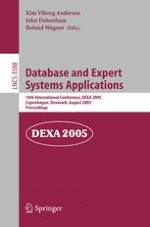DEXA 2005, the 16th International Conference on Database and Expert Systems Applications, was held at the Copenhagen Business School, Copenhagen, Denmark, from August 22 to 26, 2005. The success of the DEXA series has partly been due to the way in which it has kept abreast of recent developments by spawning specialized workshops and conferences each with its own proceedings. In 2005 the DEXA programme was co-located with the 7th International Conference on Data Warehousing and Knowledge Discovery [DaWaK 2005], the 6th International Conference on Electronic Commerce and Web Technologies [EC-Web 2005], the 4th International Conference on Electronic Government [EGOV 2005], the 2nd International Conference on Trust, Privacy, and Security in Digital Business [TrustBus 2005], the 2nd International Conference on Industrial Applications of Holonic and Multi-agent Systems [HoloMAS 2005], as well as 19 specialized workshops. These proceedings are the result of a considerable amount of hard work. Beginning with the preparation of submitted papers, the papers went through the reviewing process. This process was supported by online discussion between the reviewers to determine the final conference program. The authors of accepted papers revised their manuscripts to produce this fine collection. DEXA 2005 received 390 submissions, and from those the Program Committee selected the 92 papers in these proceedings. This year the reviewing process generated more than 1000 referee reports. The hard work of the authors, the referees and the Program Committee is gratefully acknowledged.
